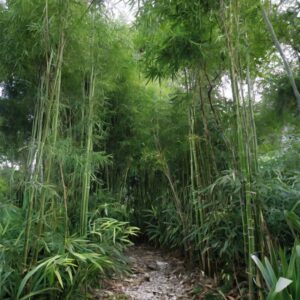
In the lush and remote regions of Asia, where the temperate bamboo forests once thrived unbroken, a quiet crisis is unfolding. The Borinda boliana, a species of bamboo, finds itself at the heart of this environmental catastrophe. Habitat fragmentation—one of the most insidious threats to biodiversity—is wreaking havoc on this species, leading to population decline and genetic isolation. This article delves into the causes of this fragmentation, its dire consequences for Borinda boliana, and the conservation strategies that might offer a glimmer of hope.
The Crisis of Habitat Fragmentation for Borinda boliana
Habitat fragmentation refers to the breaking up of continuous natural habitats into smaller, isolated patches, often as a result of human activities. For Borinda boliana, a species that relies on extensive, undisturbed tracts of bamboo forest, fragmentation spells disaster. This phenomenon is predominantly driven by deforestation and agricultural expansion, both of which have intensified with the burgeoning human population and economic activities.
Deforestation: A Major Culprit
Deforestation, primarily for timber and fuelwood, has been rampant in the regions where Borinda boliana is found. The timber industry’s unrelenting demand has led to the clearing of vast bamboo forests, reducing them to mere fragments. This not only shrinks the available habitat for Borinda boliana but also disrupts the complex ecological networks essential for its survival.
Agricultural Expansion: The Silent Invader
Agricultural expansion is another significant driver of habitat fragmentation. As human populations grow, so does the need for arable land. This has led to the conversion of bamboo forests into agricultural fields, further reducing the habitat available to Borinda boliana. The introduction of monocultures, particularly in regions that were once biodiverse bamboo forests, exacerbates the situation by creating hostile environments for the bamboo species.
The Dire Consequences
The fragmentation of Borinda boliana’s habitat has far-reaching implications. The most immediate effects are population decline and genetic isolation, both of which threaten the long-term survival of the species.
Population Decline
As their habitat becomes increasingly fragmented, populations of Borinda boliana are confined to smaller areas. These isolated patches often cannot support the same number of individuals as the original, continuous habitat. This leads to a decrease in population size, making the species more vulnerable to other threats such as disease, climate change, and invasive species.
Genetic Isolation
Perhaps more insidious than population decline is the issue of genetic isolation. When populations are fragmented, individuals are less likely to interbreed with those from other patches. This reduces genetic diversity, which is crucial for the adaptability and resilience of a species. Low genetic diversity can lead to inbreeding, which increases the prevalence of harmful genetic traits and reduces the overall fitness of the population.
Long-term Survival at Stake
The long-term survival of Borinda boliana hinges on its ability to maintain healthy, genetically diverse populations. Habitat fragmentation undermines this by creating small, isolated populations that cannot sustain themselves in the face of environmental changes and other pressures. If the current trends continue, Borinda boliana may face the grim prospect of extinction.
Conservation Strategies: A Ray of Hope
Despite the bleak outlook, there are conservation strategies that can help mitigate the effects of habitat fragmentation and promote the survival of Borinda boliana. These strategies focus on reconnecting fragmented habitats and restoring degraded areas.
Corridor Establishment
One of the most effective strategies for mitigating habitat fragmentation is the establishment of ecological corridors. These corridors are strips of natural habitat that connect isolated patches, allowing for the movement of species between them. For Borinda boliana, corridors can facilitate gene flow between fragmented populations, helping to maintain genetic diversity and reduce the risks associated with small population sizes.
Creating corridors involves identifying key areas where habitat patches can be connected and working with local communities and stakeholders to protect and restore these areas. It may also involve the creation of buffer zones around critical habitats to reduce the impact of human activities.
Reforestation Initiatives
Reforestation initiatives aim to restore degraded habitats to their former glory. For Borinda boliana, this means planting bamboo and other native species in areas where forests have been cleared. Reforestation not only expands the available habitat for Borinda boliana but also helps to restore the ecological functions of the forest, such as carbon sequestration, water regulation, and soil conservation.
Successful reforestation requires careful planning and long-term commitment. It involves selecting the right species, ensuring the availability of seeds or seedlings, and protecting the young plants from threats such as grazing animals and invasive species. Community involvement is crucial, as local people need to be engaged and benefit from the reforestation efforts.

1 thought on “8 Ways Habitat Fragmentation Threatens Borinda boliana”